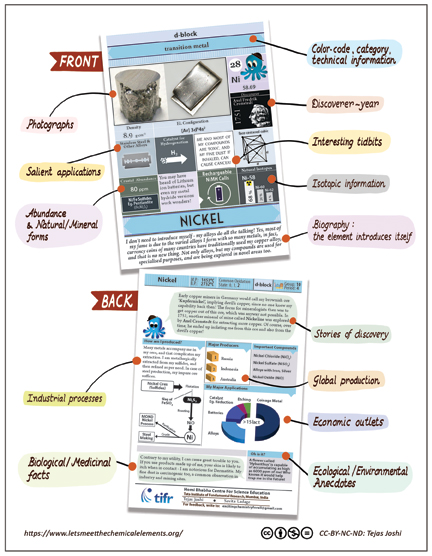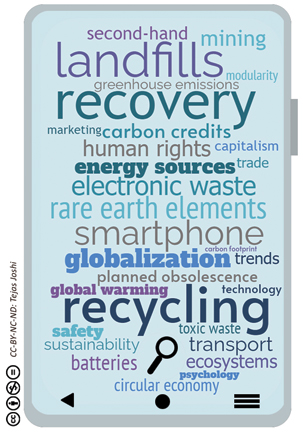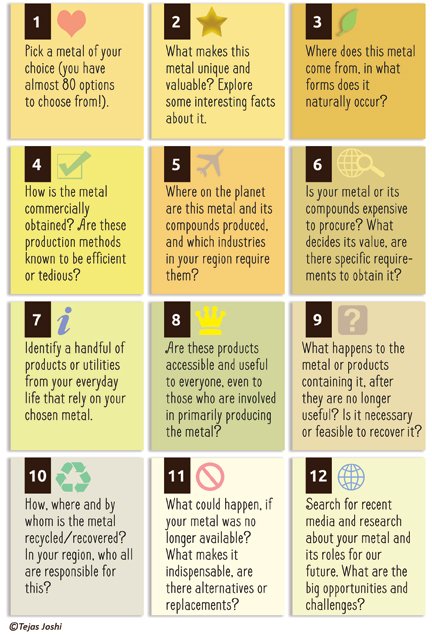Tejas Joshi
Ask a materials scientist what is paramount to achieving all the ambitious sustainability goals for our not-so-distant future and she will quickly point towards an array of chemical elements across the periodic table – a major chunk comprising the coveted metals that make up more than 75 per cent of the table. Metals underpin every aspect of our lives and have historically defined phases in human development. Against the backdrop of our global challenges, they yet again continue to be the foundation for realizing more resilient and equitable futures. Thinking about metals almost immediately brings up the quintessential periodic table – the succinct footprint of chemistry – as also the science teacher’s delight… or hurdle!
The centrality of the periodic table and chemical elements in general science curricula certainly needs no review. Having said this, their scaffolding and delivery in the classroom could be substantially remodelled in order to embed more urgent aims of science education for sustainable development (ESD)1. When designed well, a multi-faceted contextualization – coupled with learner-centred pedagogies – could lay the foundation for tomorrow’s change makers, critical citizens, and hopefully even environmental stewards! How could we, as educators and learners, transcend the traditional focus on imparting core subject knowledge, to instead interweave the teaching of the elements with perspectives relevant to the future, to frontier research, to sustainability, to economics and policy, to global-local challenges and to individual decisions?
It’s time to get creative, and metals are a great starting point!

From metals of chemistry to metals of our lives
Throughout the secondary science curriculum, the discourse on teaching the elements largely focusses on their physical and chemical aspects, and understandably so. There is considerable progression in conceptual and theoretical complexity, but it remains largely confined to the scientific domain. Apart from anecdotal mentions of their uses (often incorporated by the teacher) or production methods (again tending to core content), the absence of richer, broader contexts misses several opportunities to impart a sense of the significance of the finite elements (118 as of today) and their innumerable combinations in the modern-day life of conveniences we take for granted.
As a case-in-point to elucidate such a contextualization, Graphic 1 presents a previously developed learning resource titled “Let’s Meet the Chemical Elements!”2. Essentially a pack of 114 visual information cards, each element introduces itself to the reader, with the card structure tiled with concise snippets of knowledge highlighting specific contexts. The possibilities with such material are myriad: for one, these could blend with the existing curricular content in varying extents with co-curricular activities during as well as after lessons, or perhaps even act as a point of departure from the content (say physico-chemical properties of metals) to promote learners to independently start investigating where all they can locate the element/metal in their routine and set off a series of explorations well beyond the textbook. Seen pedagogically, the cards are simply templates for the teacher and learners (who may work singly or in groups) to choose a particular element and begin researching across subjects (such as construction, medicine, transport, technology) by deploying the internet, media, newspapers and even their local surroundings. Following this exploration is the next big step – of creatively disseminating their collected knowledge to different audiences: within the classroom and beyond it. Metals especially facilitate this process in being commonplace (almost omnipresent) and more easily discernible in various facets of life.

Three aspects are worth reflecting on here. The first is to examine whether our conventional teaching inadvertently conveys a ready-made image of the elements and periodic table, devoid of any dynamism. Or as though all the elements were always there and their properties already known. That the history and evolution of the table and the gradual incorporation of new elements are highly valuable for learning has been repeatedly emphasized by educators3. In fact, just as much as the table, the stories of discovery of the elements are fascinating by themselves and deserve a place in the curriculum! For doing so, a shift in our current handling of the periodic table and elements will be necessary, to prevent it from being a top-down, one-sided delivery of facts which are supposed to be solely “memorized” as they are. Secondly, learning about the elements is equally incomplete without delving into the future, as it opens doors to frontier research on societal or environmental challenges and thereby link core content knowledge with modern-day developments. Bridging the past, present and future whilst learning about metals is facilitated through a spectrum of current topics such as clean energy (for instance cobalt, lithium and nickel in terms of energy storage and electric vehicle batteries) or infrastructure (the already abundantly used copper, iron, aluminium) to name a few4. The third aspect is of inter disciplinarity, which, as the cards in Graphic 1 briefly highlight, is relatively easier to introduce when learning about metals across contexts. An in-depth understanding of metals is just as imperative to a biomedical researcher or urban planner as much as it would be to a civil engineer, chemist or economist – and that they are likely to closely co-operate in working towards finding answers to big questions.
In going further with the idea of a template that encourages learner-led knowledge construction, could we think about giving learners the space to at least take some ownership of how they would like to engage with the elements? Could they create their own bespoke cards for their favourite elements or convey their “stories”about the metals in innovative formats such as theatre or play?
Metals and sustainable development
Catchy titles like “These (six) metals are key to a low-carbon future” or “Sustainable metals for a circular economy” abound popular science media today5,6. A discussion on the ways7 in which the elements – metals in particular – interface with sustainable development can take up an entire volume, but the linkage provides a range of untapped opportunities for socio-scientific inquiry based learning and ESD (Education for Sustainable Development). The learning resource described above is merely one approach for contextualization, deconstructing the very “products” that we use and consume is the next step in a long journey of developing a more nuanced comprehension of how science influences developments but is also intertwined with wider societal dimensions that need to be considered as professional scientists, consumers and citizens.
The now omnipresent smartphone is a striking example in this regard. Starting with uncovering which elements and critical metals constitute a phone, what all it takes to obtain these metals, which parts of the world the phone is manufactured in, to chronicling the journey of the phone (and its components) after it gets conveniently replaced by a more advanced model, up to evaluating the impact of a seemingly diminutive phone on society and ecology, the “story” of a smartphone or practically any routinely used gadget can be harnessed in so many ways, in varying extents of complexity, to infuse a socially centred understanding of the periodic table and elements. Why not delve deeper and allow newer, more responsible, ethical ideas that challenge the status-quo, for instance the Dutch “Fairphone”8, to be discussed? What could make an existing product more sustainable, what roles would metals play in achieving this? Can we, at an individual level, contribute to the cause? Thought-provoking “stories” about such commonplace items (e.g., plastics, viz., bottled water, electronics) have been previously brought to light by projects such as the “Story of Stuff”9 or infographics like Compound Interest10 and could act as inspiration. Graphic 2 summarizes a word cloud of an ambit of themes that can be explored at this confluence. In such approaches, the aspiration is to promote students to independently seek answers to appreciate their preferred product more critically through different lenses.

From metals of our lives to metals of our future
What would happen if a particular metal was simply not available anymore? Concepts of (non-)renewable resources, climate change and sources of energy have been included in curricula across age groups, in line with broader mandates of environmental education. Teaching the elements with goals of future thinking and systems thinking means integrating environmental education topics within existing subjects, thereby not presenting them as separate “add-on” topics. Scenarios such as resource scarcity, mineral shortages or insufficient recovery rates of metals are no longer distant and avenues to start thinking about them at an early age could be pursued where possible. In case of metals, there is an interesting contrast. Whereas the reserves (viz. mineral resources) for obtaining metals are finite (and could be considered as non-renewable), the metals themselves have an unlimited lifespan and can be recycled and recovered again and again, whilst very much retaining their properties7. Thus, in an ideal situation, the onus would be on us to maximize metal recovery so as to mitigate probable resource scarcity, at the same time address the burgeoning global problem of electronic waste. How policy, legislation, individual or local decisions, or transformative designs like circular economy and green chemistry enhance or impede the pursuit of sustainability are dimensions that could at least be introduced through a more holistic approach.
To expand on this idea, Graphic 3 showcases a guided prompt-set adapted from the “Future Scientist’s Toolkit” (originally in German: “Das Future Forscher*in Toolkit”11). Designed primarily as a facilitatory tool for the elements, the open-ended questions are designed to initiate learner-led proto-research projects in small groups within the classroom as well as out-of-school settings such as (science) clubs, community and youth centres.
Some of these questions and ideas may seem daunting and admittedly complex to navigate around, both as teachers and learners. But the sooner we transition from perceiving metals as a mere topic in the syllabus to recognizing their great influence on our lives and futures, the sooner we could spark the curiosity in young minds to fruitfully engage with them and start seeing the big picture.
References
- Explainer video: “Learning to change the world! What is Education for Sustainable Development?”. Published by Deutsche UNESCO-Kommission (2021). URL: https://youtu.be/YUFqamr78Xk
- Learning resource: “Let’s Meet the Chemical Elements!”. By T. Joshi and S. Ladage: HBCSE. URL: http://www.letsmeetthechemicalelements.org
- Article: “Why you should teach the history of the periodic table”. By P. Banks: Royal Society of Chemistry Education in Chemistry (2019). URL: https://edu.rsc.org/cpd/why-you-should-teach-the-history-of-the-periodic-table/4010544.article
- Report: “There’s a Fortune to Be Made in the Obscure Metals Behind Clean Power”. By A. Janes, D. Stringer and A. Leung: Bloomberg (2021). URL: https://www.bloomberg.com/graphics/2021-materials-silver-to-lithium-worth-big-money-in-clean-energy/
- Explainer article: “These six metals are key to a low-carbon future”. By J. Timperley: Carbon Brief (2018).URL: https://www.carbonbrief.org/explainer-these-six-metals-are-key-to-a-low-carbon-future
- Blog/article: “The ‘circular economy’ in mining and metals”. By: International Council on Mining and Metals. URL: https://miningwithprinciples.com/the-circular-economy-in-mining-and-metals/
- Video: “Sustainable metals for a circular economy”. By D.Raabe. Published by the Max-Planck-Institut für Eisenforschung (2021). URL: https://youtu.be/DRnbW7_152s
- Article: “How Fairphone designed a more repairable, sustainable smartphone”. By A. Peters, published by Fast Company. URL: https://www.fastcompany.com/90692188/how-fairphone-designed-a-more-repairable-sustainable-smartphone
- Project: “The Story of Stuff”. URL: https://www.storyofstuff.org/. Recommended video: The Story of Electronics. URL: https://youtu.be/sW_7i6T_H78
- Project/learning resource: “Compound Interest”. By A. Brunning. URL: https://www.compoundchem.com/
- Learning resource: “Das Future Forscher*in Toolkit” (EN: The Future Scientist’s Toolkit). By T. Joshi. URL: https://learningamidstbeesandferns.org/
The author is an independent educationist and artist from Thane, India. Passionate about the confluence of education, science and art, he has studied and researched in India, the United Kingdom and Germany. He can be reached at tejas@oldifluff.org.
